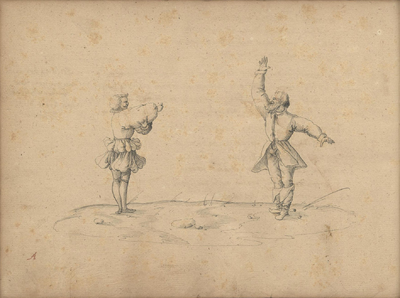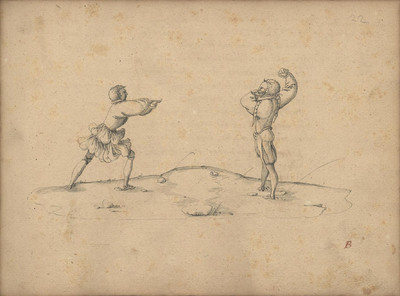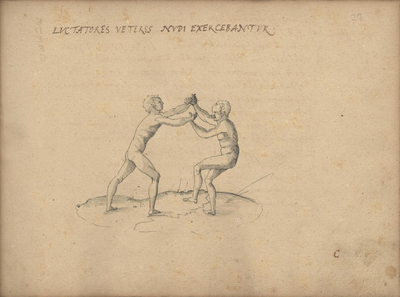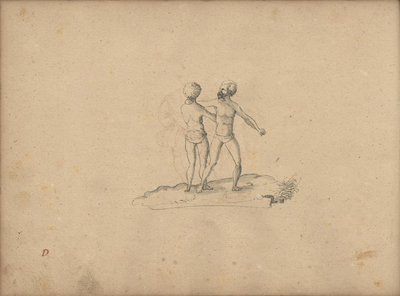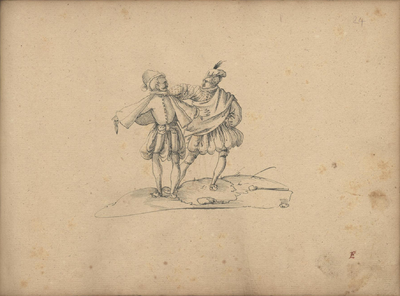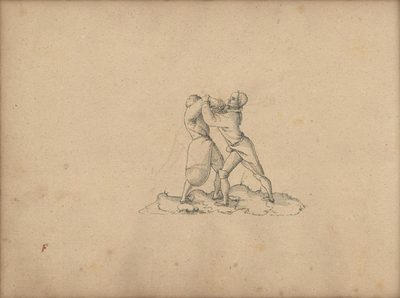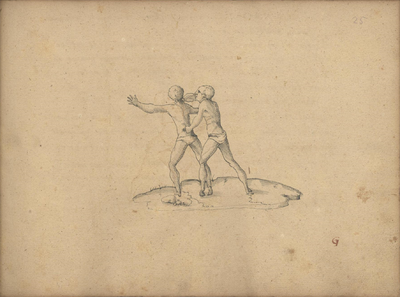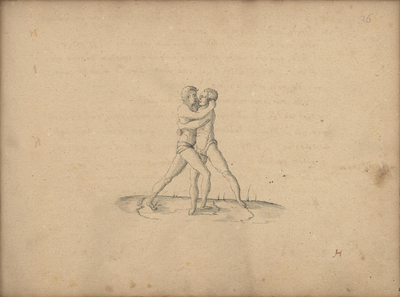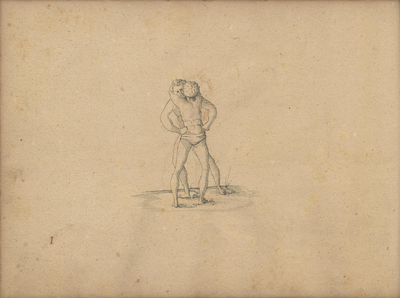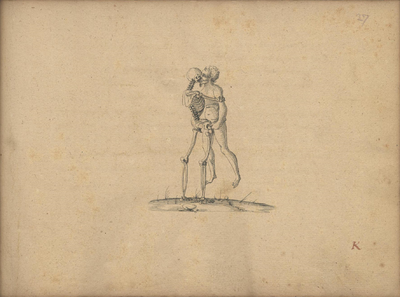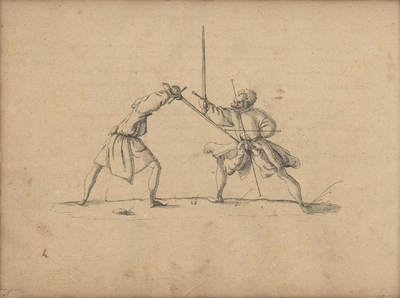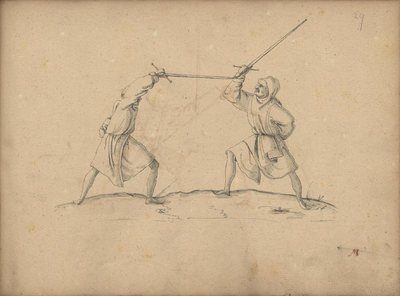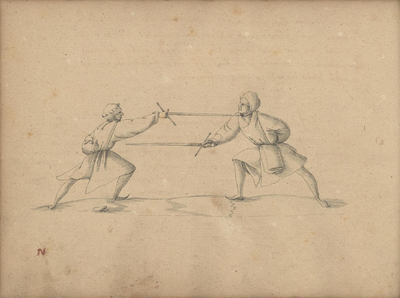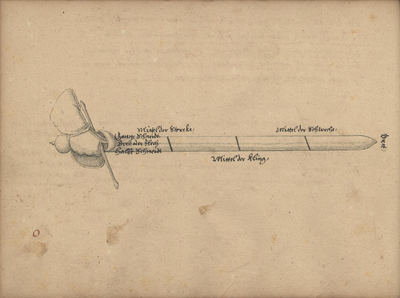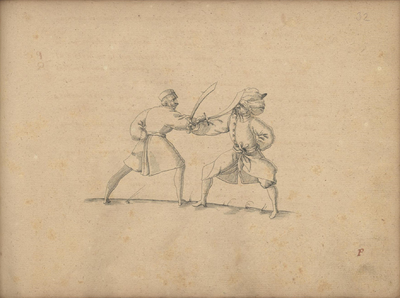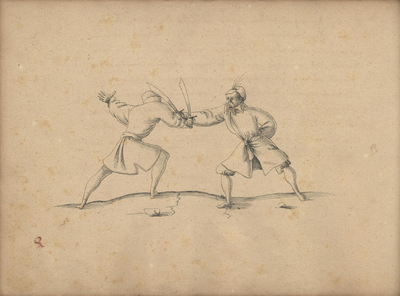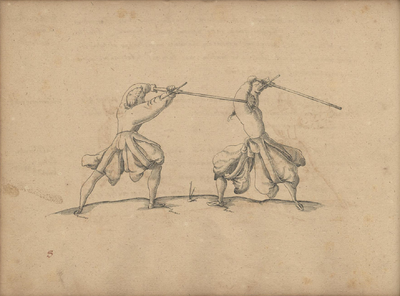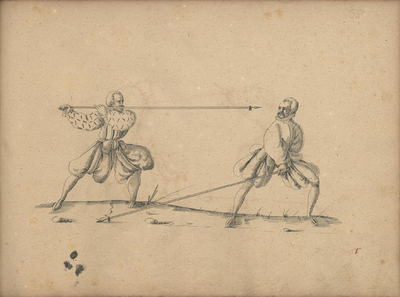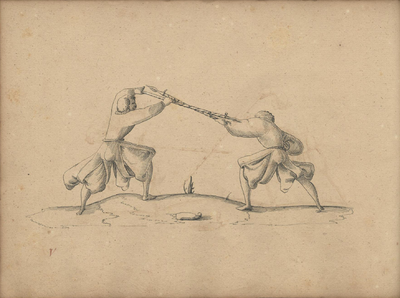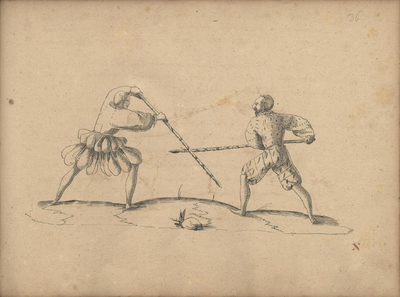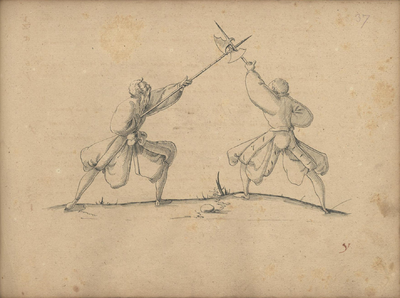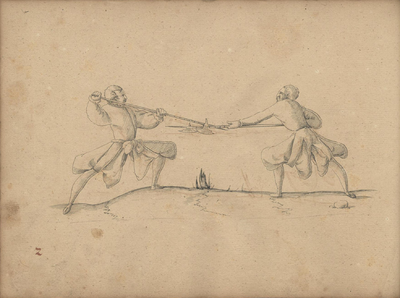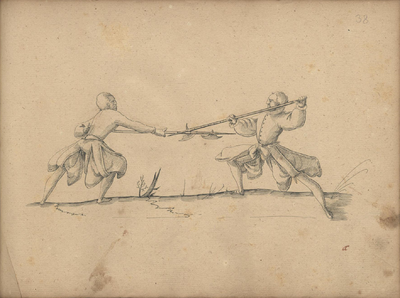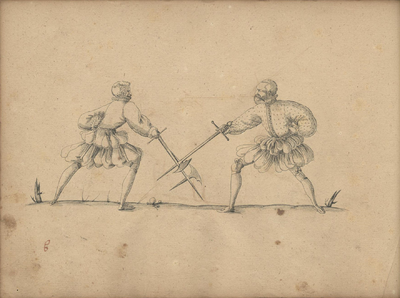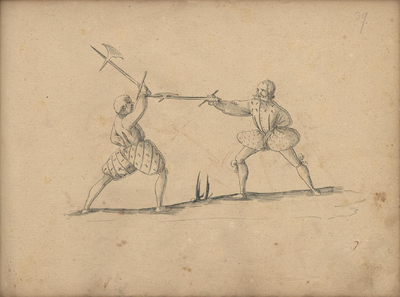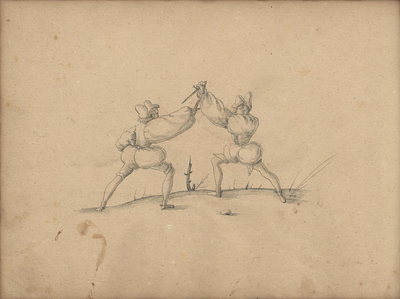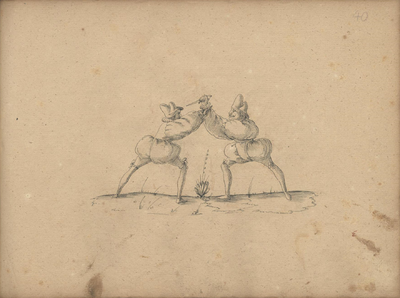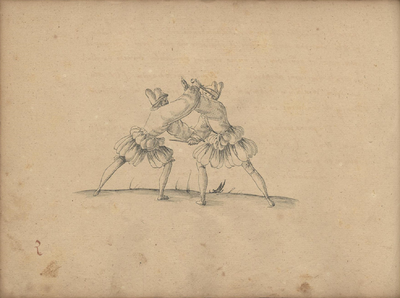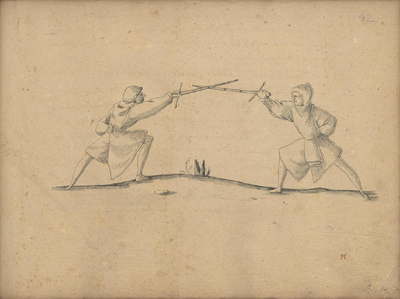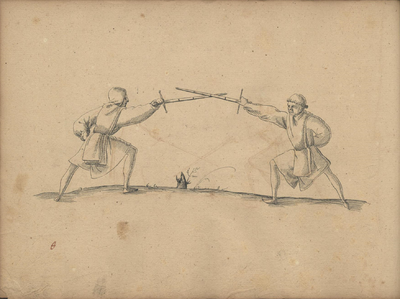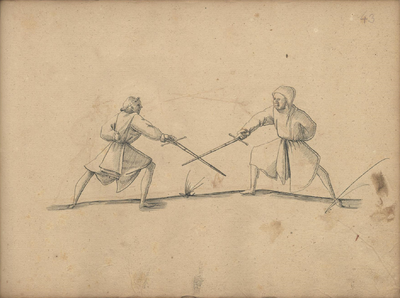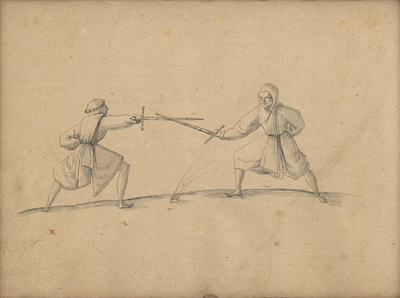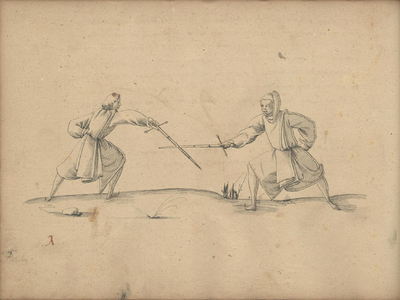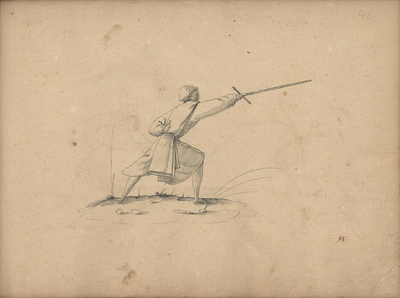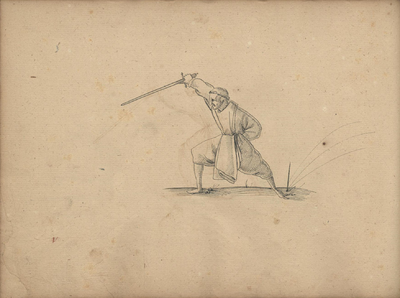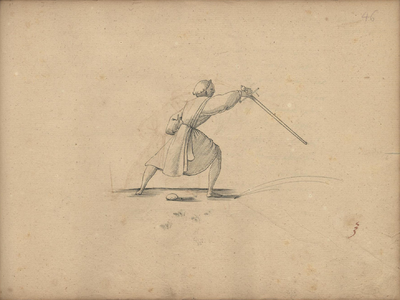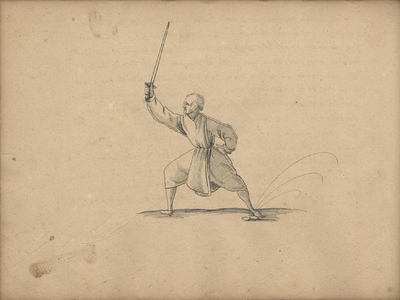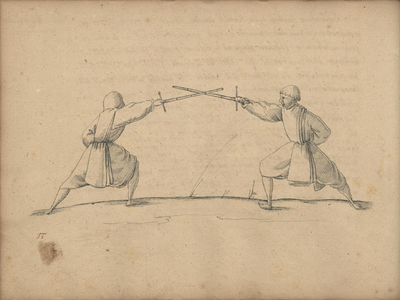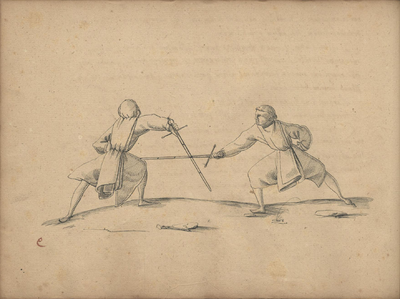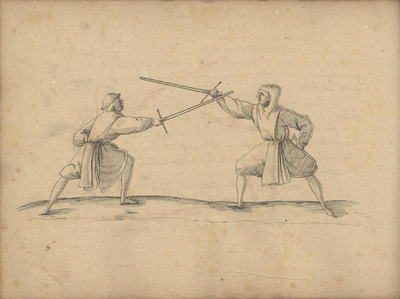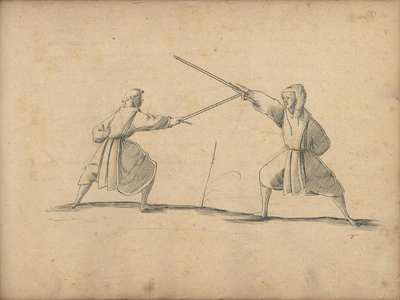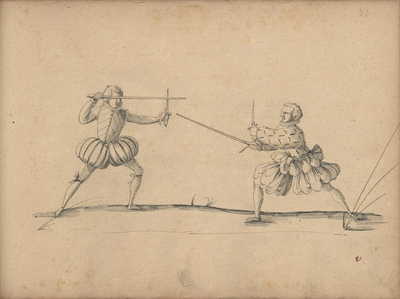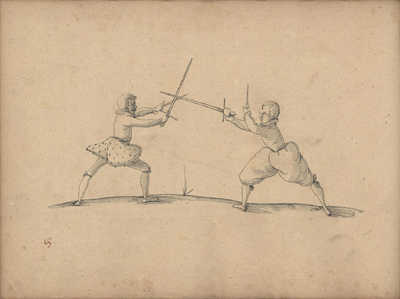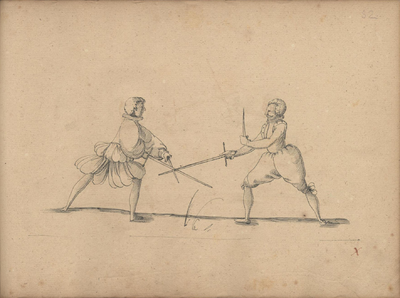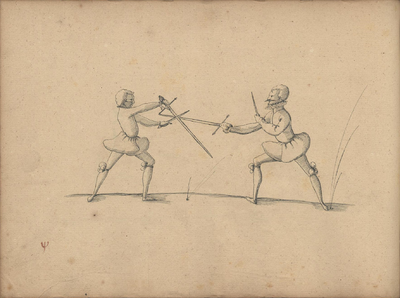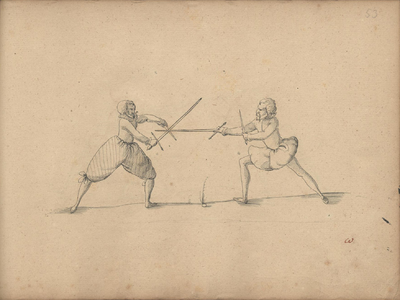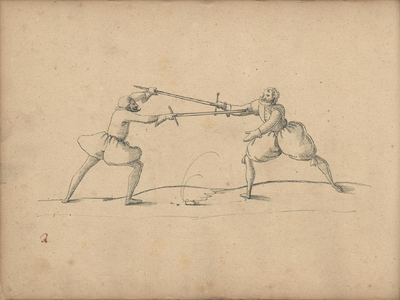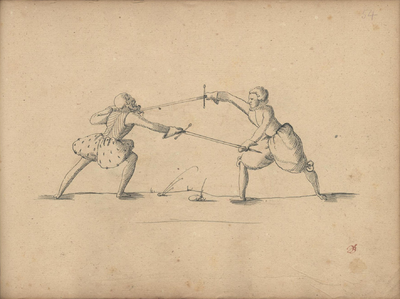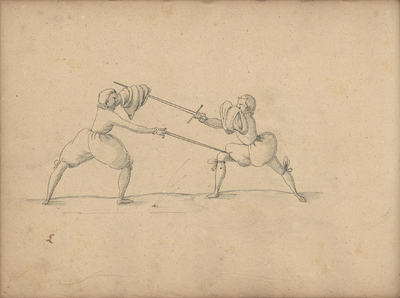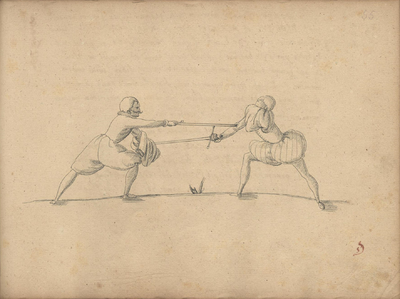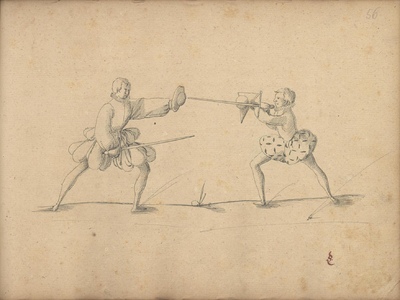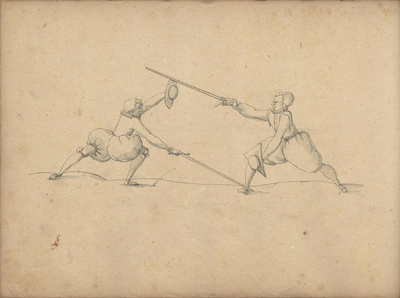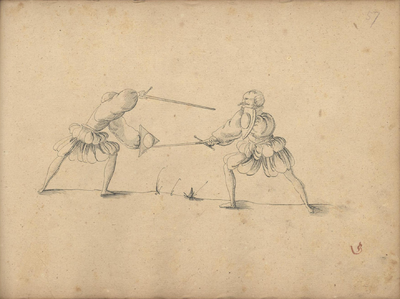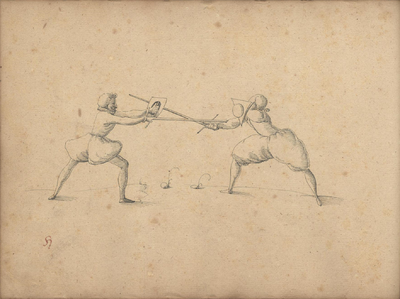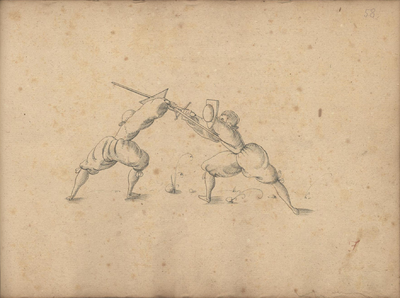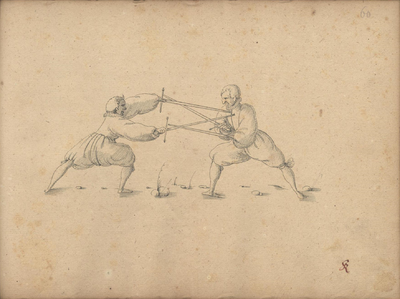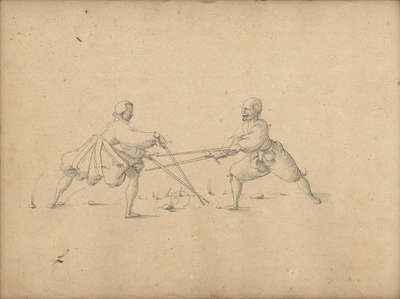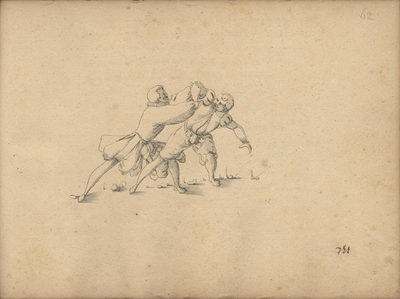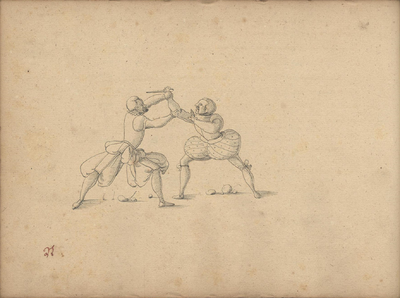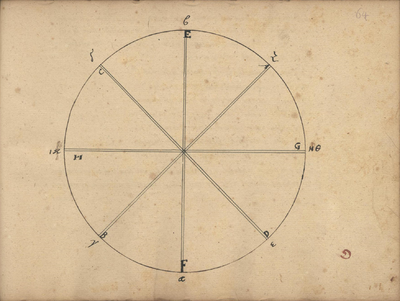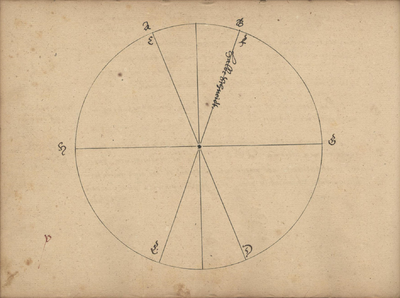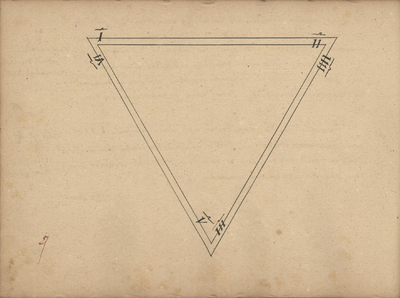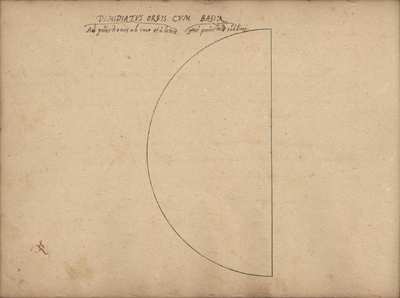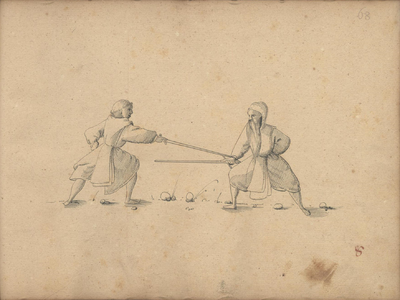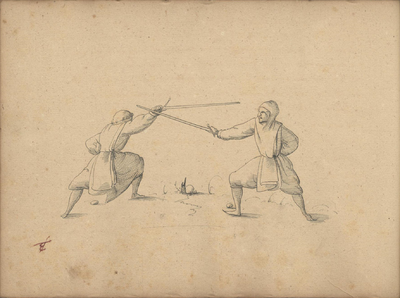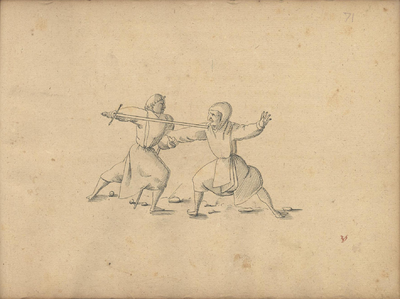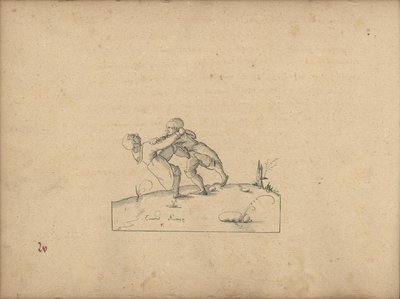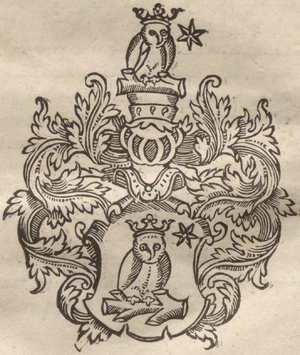|
|
You are not currently logged in. Are you accessing the unsecure (http) portal? Click here to switch to the secure portal. |
Difference between revisions of "Heinrich von Gunterrodt"
| Line 47: | Line 47: | ||
'''Heinrich von Gunterrodt''' (Henricus a Gunterrodt, Heinricus a Gunterroda) was a [[century::16th century]] Saxon nobleman and fencing historian. He was born in Lengefeld in 1557 to Hans von Gunterrodt (1526-1566) and Elisabeth von der Linda (d. 1564), probably in Schloss Rauenstein. He received an extensive education befitting the child of nobility, learning both Greek and Latin as well as studying the law. He apparently studied at the University of Wittenberg but it is unclear if he ever earned a degree. He also studied fencing under Balthasar Cramonius of Pommern and possibly also [[Johannes Herwart of Würtzburg]], discoverer of the [[Walpurgis Fechtbuch (MS I.33)|Walpurgis Fechtbuch]]. | '''Heinrich von Gunterrodt''' (Henricus a Gunterrodt, Heinricus a Gunterroda) was a [[century::16th century]] Saxon nobleman and fencing historian. He was born in Lengefeld in 1557 to Hans von Gunterrodt (1526-1566) and Elisabeth von der Linda (d. 1564), probably in Schloss Rauenstein. He received an extensive education befitting the child of nobility, learning both Greek and Latin as well as studying the law. He apparently studied at the University of Wittenberg but it is unclear if he ever earned a degree. He also studied fencing under Balthasar Cramonius of Pommern and possibly also [[Johannes Herwart of Würtzburg]], discoverer of the [[Walpurgis Fechtbuch (MS I.33)|Walpurgis Fechtbuch]]. | ||
| − | In 1579, when he was 22, Gunterrodt wrote a manuscript treatise on fencing and wrestling entitled ''[[Sciomachia et hoplomachia (MS Dresd.C.15)| | + | In 1579, when he was 22, Gunterrodt wrote a manuscript treatise on fencing and wrestling entitled ''Sciomachia et hoplomachia'' ("Unarmed and Armed Combat"; [[Sciomachia et hoplomachia (MS Dresd.C.15)|MS Dresd.C.15]]). It offers his understanding of the theory and history of fencing as well briefly treating a number of different weapon combinations including [[dussack]], [[two-handed sword]], [[spear]], and [[poleaxe]], [[rapier]] (both single and with secondary weapons), [[dagger]], and [[grappling]]. An abridged, unillustrated version of this treatise was published that same year under the title ''[[De Veris Principiis Artis Dimicatoriae (Heinrich von Gunterrodt)|De Veris Principiis Artis Dimicatoriae]]'' ("The True Principles of the Art of Fencing"). ''Sciomachia et hoplomachia'' is described as "book one", but no book two ever seems to have emerged. |
Gunderrodt's activities after 1579 are not currently known. Both versions of his treatise were dedicated to Johann Ⅶ, Duke of Mecklenburg-Schwerin. However, in 1579 Johann was controlled by a regency council and would not rule in his own right until 1585. While his father Johann Albrecht had an interest in fencing, including hiring [[Joachim Meyer]] to teach his son, and Mecklenburg would later become an important sponsor of the [[Veiterfechter]] guild, it is unknown if Gunterrodt's efforts ever earned him a court appointment. | Gunderrodt's activities after 1579 are not currently known. Both versions of his treatise were dedicated to Johann Ⅶ, Duke of Mecklenburg-Schwerin. However, in 1579 Johann was controlled by a regency council and would not rule in his own right until 1585. While his father Johann Albrecht had an interest in fencing, including hiring [[Joachim Meyer]] to teach his son, and Mecklenburg would later become an important sponsor of the [[Veiterfechter]] guild, it is unknown if Gunterrodt's efforts ever earned him a court appointment. | ||
Revision as of 02:03, 18 May 2022
| Heinrich von Gunterrodt | |
|---|---|
| Born | 1557 Lengefeld, Germany |
| Relative(s) |
|
| Patron | Johann Ⅶ of Mecklenburg |
| Genres | Fencing manual |
| Language | New Latin |
| Notable work(s) | De Veris Principiis Artis Dimicatoriae (1579) |
| Manuscript(s) | MS Dresd.C.15 (1579) |
Heinrich von Gunterrodt (Henricus a Gunterrodt, Heinricus a Gunterroda) was a 16th century Saxon nobleman and fencing historian. He was born in Lengefeld in 1557 to Hans von Gunterrodt (1526-1566) and Elisabeth von der Linda (d. 1564), probably in Schloss Rauenstein. He received an extensive education befitting the child of nobility, learning both Greek and Latin as well as studying the law. He apparently studied at the University of Wittenberg but it is unclear if he ever earned a degree. He also studied fencing under Balthasar Cramonius of Pommern and possibly also Johannes Herwart of Würtzburg, discoverer of the Walpurgis Fechtbuch.
In 1579, when he was 22, Gunterrodt wrote a manuscript treatise on fencing and wrestling entitled Sciomachia et hoplomachia ("Unarmed and Armed Combat"; MS Dresd.C.15). It offers his understanding of the theory and history of fencing as well briefly treating a number of different weapon combinations including dussack, two-handed sword, spear, and poleaxe, rapier (both single and with secondary weapons), dagger, and grappling. An abridged, unillustrated version of this treatise was published that same year under the title De Veris Principiis Artis Dimicatoriae ("The True Principles of the Art of Fencing"). Sciomachia et hoplomachia is described as "book one", but no book two ever seems to have emerged.
Gunderrodt's activities after 1579 are not currently known. Both versions of his treatise were dedicated to Johann Ⅶ, Duke of Mecklenburg-Schwerin. However, in 1579 Johann was controlled by a regency council and would not rule in his own right until 1585. While his father Johann Albrecht had an interest in fencing, including hiring Joachim Meyer to teach his son, and Mecklenburg would later become an important sponsor of the Veiterfechter guild, it is unknown if Gunterrodt's efforts ever earned him a court appointment.
Contents
Treatise
Illustrations |
Sciomachia et hoplomachia (1579) |
De Veris Principiis Artis Dimicatoriae (1579) | |
|---|---|---|---|
[1] Henrici à Gunterrodt, DE VERIS PRINCIPIIS ARTIS DIMICATORIAE, Tractatus breuis, AD ILLUSTRISSIMUM PRINCIPE MIO HANNEM Ducem Megapolensem. WITEBERGAE Excudebat Mattheus Welack. Anno Ⅿ. Ⅾ. ⅬⅩⅩⅨ. | |||
[2] EPIGAMMA IOHANNIS MAIORIS D. COrporis in motus mentis se suscitat ardor: | |||
|
[3] ILLVSTRISSIMO PRINCIPI AC DOMINO, DOMINO IOHANNI DVCI MEGAPOLENSI, PRINCIPI vetustae gentis Henetae, Comiti Suerinensi, Domino Rostochij & Stargardiae Dominosuo clementissimo, S. P. D. MIRVM FORTASSE VIderi poterat Illustrissime Princeps, quod hoc tempore ausus sim Celsitudinem tuam compellare, in tam tenui praesertim argumento: Sed facile, ut spero, apud Celsitudinem uam excusabor, & ab omni sinistrae suspicionis nota apud candidos lectores liberabor, quod in Excelsitatis tuae nomen hanc meam scriptionem, in qua leviter defunctus sum, apparere volverim, si intelligent me huius negotij Patronim delegiste heroem eum, qui in exercitatione luctae, sive arte dimicandi egregiam habeat cognitionem ac [4.1] usum, hoc est, exercitatione praeditus sit. Quapropter, id quod decorum est observasse me existimandus potius, quam in temeritatis crimen vocandus sum: tantum abesttvt obtrectationem hac in parte metuam, cum apud intelligentem artis, de arte tractationem susceperim, cuius nimirum autoritas meum conatum ab iniquorum sermonibus vinidare possit. | |||
|
[4.2] Verum vt omnibus partibus ac numeris absolutam rationem artis huius traderem, in hac tractatione mihi propositum non fuit, sed commenmorationem saltem, ac summa capita quaedam de veris eius fundamentis strictim ex habeo, Neque enim omnes regulas, regulas, quibus solida eius cognitio nititur, in medium afferre mihi integrum suit, ne aut palmam praeripere ci, qui me ad eam disciplinam erudiit, aut laudem cognitionis, qua discipulo antecellit Magister, detrahere existimarer, in quem modum & Alciatus lib: de singulari certamine, Cap. 31. grauiter differit Interea hoc saltem consilio haec artis semina in luce exire volui, vt alios ad vberiorem frugem Theoriam vel artis huius proatiora initia haberent, propter vtilitatem publicam ea etiam in medium proferrent, quo & ab interitu liberati & à contempt imperitorum [5] vindicari haec ingénue ac ingenuis hominibus digna ars queat. Has autem commentationes Excelsitas tua beneuolè accipietm, si ad stadium submissum meum erga se potius, quàm ad splendorem earum repexerit: Sunt enim si ex pondere suo censeantur tenuiores, quàm vt tanti principlis arbitrio satisfacere possint: si ex artis dignitate spectentur, tanto nomini non indecores: si ex studio meo, probandae etiam erunt. Veruntamen si haec rudimenta, tanquam gradus primos artis luctatoriae à me iactos, benign complectetur excelsitas tua, fieri potest, vt & de voluntate Magistri in hac arte mei, & ex industria mea perfectum, magisque solidum opus extruam, & fastigium illi imponam summum. Benè & feliciter vale. Datae Witeberge ex Musaeo, eo ipso die, quo ante annos 1579. Filius Dei natus est, & assumtione naturae humanae resituit nos Deo parti, & perpetua gestatione ac sustentatione eiusdem confirmat, nos sibi perpetuae curae esse. T. Excels. Submissus Henricus à Gunterrodt. | |||
|
[6] AD ILLVSTRISS: PRINCIPEM IOHANNEM DVCEM MEGAPOLENSEM commendatio palaestrae Nobil: à GVNTERRODT. NObilibus sua fama Viris à stirpe, sed illam |
Illustrations |
Sciomachia et hoplomachia (1579) |
De Veris Principiis Artis Dimicatoriae (1579) | |
|---|---|---|---|
|
[11] DE VERIS PRINCIPIIS ARTIS DIMICATORIAE. PAlaestricam siue dimicatoriam arte omnium luctationum, quae ad corporis exercitationem susceptae sunt, praestantißimam, in usu minus frenquenti esse, insuperque in contemptum apud Germania populous, qui quidem fortitudinis commendationem adepti fuerunt, venisse, mirum certe non est: cum plerique huius magistri tam male hodie, propter dissolutam viuendi rationem & ignauiae suspitionem, audient: Vt Galeno altero opus esset, qui contra vitiosam Gymnasticam siue athleticam calamum stringeret. Reipsa enim Herclidem pugilem quidam referent, quem immense propè cibi, protusque capacem fuisse ferunt, non enim reperiebatur par ipsi in potando, alios ad ientaculum inuitabat, alios ad prandium, ad coenem alios, postremos ad commenssationem, recedentibus primis reponebantur secundi, omnesque [12] praestabat vnus. Ac licet multa veterum Athletarum proferri poßint eximiae continentiae exempla, tamen eorum plurimi contrarium obseruant, idque laudi sibi ducunt, si intemperanter vtantus potis, & se in omnia voluptatum coeno volutent. In palaestra plures sunt Chironomi & Acrochiristae, hoc est, qui motus gestusque informant, ac vmbratili quadam luctationis specie corpus alque artem suam iactitare student, ad ostentationem solùm comparati, nullam certam methodum in instituendo obseruantes, imò ipsi certis regulis non sunt instructi neque astricti, sed quando manus conserendae sunt, artis hoc certum experimentum esse volunt, si furiosorum more clausis oculis, quemadmodum de Andabatis memoriae proditum est, sine artis ac mentis ratione plagas ducant: Et quoniam plerunque armis non incidentibus, sed rudibus in spectaculis publicis pùgnetur, tantum antagonist caput petunt, hancque partum corporis solummodò, coeteris neglectis, ipsimet protegunt, & brachiis, licet non sine periculo interdum, ceu vallo muniunt, nihil interim solliciti, [11.1] sive punctim sive caesim reliqua eorum membra ab antimacho, hoc est, ab eo qui ex adverso luctatur, feriantur, ut minimum susm talis ipsorum ars in vero certamine habere: videatur. Hinc fit ut plurimis spectatoribus persuasum sit, haud ullam utilitatem afferre huius artis peritiam, & quod de eiusmodit gladiatoribus verum est, ipsi arti male asseribant: fundamento destitutam iudicent, agilitatem corporis tantummodo esse, & robu principalem causam putent. In quo tamen non parum a scopo aberrant. Habet etenim haec ars non minus quam aliae, certissima & perfectissima (licet paucissimi haec teneant) fundamenta, de quibus aliquid in medium affere decreui, breviter quidem & eo ordine, ut antiquitates Graecas & Romanas, inventores etiam Palaestricae non penitus silentio praeteream. | |||
[11.2] Gymnici Ludi a Lycaone in Arcadia primum inventi sunt, ut autor est Plinius lib: 7 cap. 56. | |||
|
[11.3] In Graecia autem primum certamina instituta sunt, & celebratissima numerantur, Olumpia, Pythia, Nemaea, Isthmia. Hercules enim [12.1] Augea, Elidis rege superato, repurgatoque eius stabulo, in campis Olympiae vicinis sacrum certamen instituit, quod quarto quoque anno (vel ut Lycophrotis interpres asserit quinquagesimo mense) celebraretur, idque eo consilio, ut in illo Graeciae Juventus sese Pentathlo sive quinquertio exerceret, cursu scilicet saltus, disco, caesibus, & palalaestra, iisque veluti meditationibus vero certamini praeluderet. Huic quinto die fiis imponebatur, & victor (qui olympionices vocabatur) oleastro, qui ut Aristoteli placet, philostephanos dicitur, coronabatur, adeoque magni ea Gloria aestimabatur, ut plerosque constet huiusmodi nuncio de filiorum vicotira accepto, prae laeticia in fata concessisse: tatum enim victori habebatur honoris, ut non per portas urbis, sed per ruinas murorum in curru sublimis in patriam reveheretur. Inde Cicero pro L. Flacc: Acinas, inquit, pugil Olumpionices, quod prope magis est, & gloriosius quam Romae triumphasse. | |||
|
[12.2] Pythia Ludi Apollinares in Apollinis honorem institute, ob coedem Pythonis serpentis [13.1] nocentissimi, aut Strabo lib: 9 scribit, hominis scleratissimi, cognomento Draconis. Ex hoc certamine victor coronam leuream cum malis reportabat. Nam quod Ovidius Pythiorum victori AEsculeam coronam videtur tribuere, m lib: 1 Metamor: cum ait:
| |||
|
[13.2] In ex animi sentential non scripsisse illum, sed ut commodiorem ad fabulam Daphnes faceret transitum, constat ex eo quod subdit: Nondum Lauris erat. | |||
|
[13.3] Nemaea, quorum victores apio coronabantur, ita appellate a Nemaee sylva Peloponensi, in qua fieri consueverunt in honorem Herculis, qui leonem in ea sylva fertur occidisse, seu multo magis in honorem Archemori pueri, Lycurgi filii in ea sylva a perpente occisi. | |||
|
[13.4] Ishthmia, in quibus qui vicisset coronam ex pinu reportabat, Sic dicta ab Isthmo Peloponesi in cuius faucibus celebrabantur non procul a teplo Ne- [14.1] ptuni, in cuius honorem etiam institute sunt a Theseo, ut Plutarcho videtur. Sic enim de institutione horum ludorum in vita Thesei scribit: Theseus primus Neptuno certamen instituit, gloriarique, est solitus, ob Herculem Olympia Jovi, ob se vero Isthmia Neptuno celebrari. Quod enim ibidem in Melicertae honore institutum est, noctu agebatur initiandi magis, quam spectaculi speciem proferens. Vel potius in honorem Palaemonis (quem Latini Portunum vocant, unde & Portunalia dicebantur) ut ex Archiae Poetae nobili Epogrammate graeco, de his quatuor certaminebus, quod etiam hodie circumfertur, colligitur. Versus hi sunt:
| |||
|
[14.2] Hoc loco etiam notatu dignum est quod tradit Lucianus Athletarum & pancratiasta- [15] rum sortitionem describens, in argenteam (inquit) calpin, id est, urnam coniiciebantur minutulae sortes, faba non ampliores. Eo semper orfine servato, ut binis eadem inscriberetur elementi nota: pro athletarum numero sortibus item auctioribus. Quum impenderet certandi tepus, prodibant ex athletis singuli sortem educturi, nec inspectandi productam ius reat, quando id prohibebat assistems mastigophorus. Peracto autem orbe, ambiens Alytarchus inspectabat sortes, atque ita dispensabat, ut qui alpha esset sortitus, cum eo componeretur qui eandem eduxisset literam: atque ita deinceps homogrammi certaturi prodibant. Fieri vero sic moris erat, si certaturi pares suissent. Quod si quinque aut septem, coniiciebantur in urnam solitaria litera, quae antigraphon sive antigramma non baeret, Qui vero eam eduxisset, residebat expectans quandiu certarent alii, congressurus mox cum fatigatis vigens ipse atque integer adhuc viribus. Quod sane vel foel icissimum censebatur. Dicebatur vero hic Ephedrus, id est, [Greek] quae vox apud Sophclem in Aiace [16.1] mastigophoro, indicat novissimum. Coel lib: 22. Cap. 18. antiq. Lect. | |||
|
[16.2] In hisce vero certaminibus primarium locum sine omni dubio obtinuit palaestra, cuius tres praecipuae species recensentur. Prima πάλμ lucta, unde πάλουsικοϱ luctator, quis adversarium permere & retinere valet, graeci a concussion, Latini ita dixerunt a motus, unde etiam luxare. Creditur inventa esse a PHORBANTE poedotriba Thesei Athenis, quod tamen aliqui ipsi protius tribwnt Theseo. Haud autem uno modo luctabatur. Aliquando amplexu mutuo ab iliis & humeris, interdum consertis brachiis manu apprehensis, Item impulse tantum certabtur & tractu, & pressione, & supplantatione, ut non caederetur concertator, sed prosterneretur. Secunda, Pugilatus: Pugil autem πύμτμϱ graece dicitur, qui pugno plagas impingere potest & solo percussu adversarium prosternere. Primum certamen olim pugnis nudis factum est, itaque πυξ gracis, Latinis pugna, inde etiam pugnus, quoniam manus quae erat antea passa, & αμιχϱ, unde nomen [17] habet, clausis digitis effecta est πύμιμ densa. Pugnis deinde addita lora ad minimetum, proptereae qud nudi cum ferirent, saepa plus damni acciperent, quam facerent. Ea lora graeco vocabulo caestus dicti, brevia initio, mox ne excussa exuerentur in ictibus, tum cubito tum humero alligebantur. Postremo ferrum plumbumque assutum est saevissimo spectaculo. Cerebrum enim ac guttur facillime elidebant, idcirco aurium munimenta induebant, άμφώταϱ Tota ars, Ictum vitare non fuga, sed corporis inclinationibus & flexionibus. Postremo ne inferre ictum frustra, conceidebant enim plumbi pondere praecipites acti, si impensius niterentur verberare. Tertia species: Pancratium, ex lucta & pugilatu compositum, Pancratiastes enim is dicitur, qui corporis totius conatu, omnique virium contentione insurgit in pugnam, eapropter πάμμαχoϱ quoque vocatur, ad pugnam vocatus, Gellio teste, projectis alte brachiis consistit, caputque & os suum manibus oppositis, quasi vallo praemnit: congressus inde par- [18.1] tim apprehendendo luctari, partim feriendo pugilem videtur agere. Theseus hoc genus creditor reperisse, quando in Creta absque gladio Minotaurum aggressus est. Cael.lib. 13. antiq.lect.Palaestricen quoque totam invenit, & ab eo profectae Palaestritarii disciplina, ab euis rei magistris celebrari coepta, cum antea sola corporis manitudine & robore certaretur, Hac ipsa etiam Cercionem, qui omnes alios secum pugnantes occidit, super avit, ut scribit Pausan. In Att. Quanquam antiquius hoc inventum (graecorum tamen) esse videatur, quo etiam ab Hercule Antaeus superatus fuerit, ut constat ex Epigrammate Dyothimi latine ab Andrea Alcrato Jurisconsulto doctissimo sic redditum:
| |||
|
[18.2] In Pancratio inter caeteros clarus memora- [19.1] tur fuisse Sostratus Sycionius cognomento Acrochersites, qui hoc Stratagemate fertur usus esse, arreptis extremis adversarii minibus eas frangebat, nec prius dimittebat, quam sensisset eum deficere. In lucta Leontiscus palaestrita Siciliensis, haud alio more quam Sostratus in Pancratio adversaries percellebat. Neque enim colluctatione sternebat, sed victoriam summis digitis collidendis extorquebat. Hunc tradit Suid institutum esse apud Clearchum discipulum Euchiri Corinthii & Chilonis Paterensis. | |||
|
[19.2] Apud Romanos deinde maximo in pretio & summum ob stadium celeberrimam fuisse hanc artem ex eo certissimum est, quod non solum gladiators suos (qui venali sanguine in arena decertarent, quos magistri & institutores quibus Lanistarum nomen erat, ex servorum delectu ac libertorum comparabant, quorum genera quatuor, Retiarii, Secutores, Myrmillones, Hoplomachi, qui ea potissimum causa in ludis comitti solebant, ut hoc spectaculo assuefacti tyrones, [20.1] cruentum hostem non expauescerent) habuerunt, sed in hoc munere etiam liberae conditionis homines nomen dederunt, ut specimen virtutis animo insitum ostenderent. Imo postea, hac ipsa instructi multi inventi sunt Imperatores, illustres viri atque duces, qui monomachiam exercere soliti, & adversus quemlibet Athletam robere contendere ausi sint, qualem Neronem, Trajanum, Antonium & Severum accepimus, quos praeterquam quod hac sola arte sanitatem conservasse, fortissimosque evasille traditum est, ob hanc quoque causam eos fecille veritati consentaneum videtur, ut suo exemplo reliquos ad euis modi exercitia invitarent. | |||
|
[20.2] Veteres quoque Germanos, qui semper antiqua etiam vertite & invicto animi robore claruerunt, non in minori existimatione eam habuisse, tam certum est, ut probatione nulla indigeat. Scribit Saxo lib:6. Ham am apud Saxones gymnicis palmis clarissimum habitum esse, adeo ut magno military pompa tripudio ductus sit ad conflictum, & Starcathero inter Danos fortissimo, sed capulari oppositus. Quum [21.1] in conflictum ambo descendissent, aest arentque hinc & inde numerosi spectatores, ut suo victori insuliu propter invalidas vires pene resupinatus est, verum ubi tanqam ignominiam a se repellens resumpsit vires, & se sibi resituit, medium Hamae corpus dissecuit. | |||
|
[21.2] Nunc autem ad nostra tempora veniam. Et quia exterarum gentium nobilissimi pugiles mihi prorsus sunt ignoti, ac tantum aliquorum discipulos vidi & cognovi: Judicium de iis facere nolo. Quo ad Germaniam vero: Duae factions extiterunt: una ex parte ut plurimum pelliones, & alii opifices cum his confoederati, quorum etiam aliqui magistri in arte, praesertim gladium tractandi, haberi volun, qui ex speciali Romanorum Imperatiorum & Regum Privilegio, in nundinis Francofurdiensibus, quos in arte excellere putant, & in eorum sectam qui iurare volunt, eodem titulo insignire solent. Alteri his opposite plerunque studiosi bonarum disciplinarum & aliarum atrium minus sordidarum periti, [22] qui certe illis arte praestant, quamuis rarissimi etiam inter hos reperiantus, qui certum fundamentum habeant, & discipulos suos rationibus certis instituere possint. Repertus est ante annos aliquot Argentinensis quidam Joachimus Meier, qui conatus est firmas regulas demonstrare, & volumen etiam magnum hac ipsa de arte edidit germanico Idiomate, & licet aliquid intellixisse videatur, usum tamen istorum fundamentorum non commonstravit. De veris igitur principiis aliquid commemorare constitui, quod eo melius & facilius, ut spero, facere potero, quoniam & librum vetustissimum compositum a Monachis nobilibus (sicuti enim multi clarissimi Imperatores & duces belli vita fere peracta, sese in monasteria abdere solent, ubi in otio saepius recordantus praeliorum, quibus prafuerunt & quando victi sunt, causas que quomodo praevenire potuerint considerant, posteritati deinde scriptis consulere possunt: ita & nobiles quondam, qui plerunque erant fortes & peritissimi tam in per destri, quam equestri pugna, tandem veterani & [23] emeriti vitam monasticam elegerunt, propter consuetum autem laborem in otio vivere non potuerunt, sed ad valetudinem tuendam certis horis haec exercitia haberunt, tandem certum fundamentum invenisse eos mirum non est) describendum & depingendu nactus sum, a Johanne Herwarto Herbipolensi, Zonario, & gladiatore celebrato, (cum quo magna familiaritas mihi intercessit) per id tempus Principis Illustrissimi Friderici Wilhelmi ducis Saxoniae Lanista, Qui illum in monasterio Franconiae, cum militem ageret sub Marchione Alberto se reperisse, mihi retulit. Et quia informatore ad hanc artem usus sum fidelissimo Balthasaro Cramonio Polnauiensi Pomerano, Medicinae studioso & discipulo huius Herwarti, non minus in hac ipsa scientia celebri, praesertim si armis incidentibus pugna ineunda sit, ta certa enim & indubitata artis sus habet principia, ut neminem quondam reformidasset. Ante semestre autem a pessimus nebulonibus sceleratissme vulneratus, sinistrum que brachium mutilum ipsi redditum, dextra adhuc est practicus. In [24.1] armorum autem generibus quibus tractandis duarum manuum ministerio opus est, bonus theoricus, & demonstratione satisfacere discipulis potest. His ambobus vere gymnastarum competit definition a Ravisio descripta, cum sic ait: | |||
|
[24.2] Lanistae & gladiators dicuntur, qui veram non umbratilem digladiandi artem profitentur: quique numeros omnes impetendi, caedendi, inferenique & vitandi vulnera, atque etiam ubi punctim caesimque feriendum sit, discipulos docent, ut si quando in pugnam prodeundum sit, tutentur se melius & inimicos invadent cautius. | |||
|
[24.3] Tam certo enim eorum ars nititur fundamento, ut recessione & corporis declinatione discipuli eorum, modo recte edocti fuerint, & diligentia sua practice evadant, ad vitandos ictus haud ops habeant (cuius rei non rarum specimen ostendit Doctissimus D. Magister & strenuous dimicator Johannes Wilhelmus Neunowel Jenensis, euis ego quidem comes & tanquam alter Pyrrithous, ac quasi aemulus studiorum fui, merito autem illi palmam do, vix enim simulachrum aliquod in- [25.1] signis ipsus fortitudinis referre possum. Aquo utinam Theso in hoc meo scripto adiwari potuissem) Quamuis modus ille exteris nationibus usitatissimus, minime improbandus, sed suo loco summa laude digna sit illa agilitas. Ut igitur ad rem ispam accedam, Definitionem tantummodo Palaestricae sive potius dimicatoriae artis tradam, in cuius tamen explicatione non pauca de fundamentis attingam. Sit itque haec descriptio. | |||
[25.2] DIMICATIO est ingénue, virilise & nobilissima ars Gymnastica, Ex principiis naturae, certissimis fundamentis, ferfectissimisque; figuris demonstrate, quae & gladiatori, & milit, cuicunq; deniq; ad se, in Pancratio, praeliis & monomachiis, quibuslibet armis manuariis, nec non colluctatione, fortiter defendum, & de Antagonista, vel hoste, aut adversario, victoriam reportandam prodest. Exercenda sanitatis conservandae, & robusti corporis habitus acquirendi causa, gloriae quoque; ac virtutis gratia. | |||
|
[25.3] Dimicationem appelo. Plerunque enim dimico accipitur pro pugno, quod proprie sit re, & [26.1] quia Monachi probatissimi huius artis scriptores ita nominant, qui eam sic definiunt: | |||
[26.2] Dimicatio est divisarnm plagarum ordinatio. | |||
[26.3] Pono genus, quod sit ars, constat etenim ex collection praeceptorum, iisque arctißimis concluditur. Dico Ingenuam, quia inter liberales artes, quae solum ingenii, non manuum ministerio peraguntur, non potest numerari, cum ad hanc corporis major quam animi habitus requiratur: quia tamen firmißimis principiis, regulis perfectißimis & ingeniosißimis nititur, merito hunc titulum sortitur, nec inter mechanicas sive illiberales recensetur, nam & Jureconsultus l. 4. ff de qui notant. Infamy, inquit, quod Julius & Caßis responderunt: Atheletas omino artem ludicram non facere. | |||
[26.4] Item: Virilem, quod strenuous in iis augeat. | |||
|
[26.5] Addo: Nobilissima Gymnastica, Platronem secutus, qui tanti eam fecit, ut coeteris exercitationum generibus, pro offensione simul & defensione praeposuerit, nec ulla exercitatione inferiorem hanc esse, aut minus [27.1] laboriosam velit. Sequitur, Ex principiis naturae. Oculari videlicet demonstratione, quae tam certa est, ut nemo [Greek] habens, sive ratione naturali praeditus negare possit, praesertim cum omnis intuitive noticia sit optima definition, ac reipsa comprobari & verberibus demonstrari queat, si verbis fides non habeatur. Certissimis fundamentis, Ex partitione videlicet tum corporis humaeni tum armorum usitatorum, juxta versiculum:
| |||
|
[27.2] [Margin: Tehilung des Leibs / In die Sterken und Schwechen / in nechste vnd weiteste blossen.] Ad corpus quod attinet dividitur hoc in membra debiliora & firmiora. In partes tem quae sunt vel fiunt laesioni obnoxiae propinquas & remotas. Ubi etiam decetur, quomodo se possit quisque intendere ad firmitatem, de quo Cicero aliquid 2 Tuscul: Exclamant, inquit, quam [28.1] maxime possunt, cum exercentur Athletae. Pugiles vero etiam cum feriunt adversarium, in jactandis caestibus ingemiscunt, non quod doleant, anomove succumbant, se quia in profundenda voce omne corpus intenditur, venitque plaga vehementior. | |||
[28.2] Armorum autem usitorum genera varia sunt, quorum praecipua nomina, ut maxime potero, propria recensebo. | |||
[28.3] Primum in usu est Dussaken/ quod genus vocare licebit, Acinacin sive Harpen, forma etenim convenit: praetera a Thussagetis populis in Scythia ultra Sauromatas, qui sicuti Persae tam brevibus falcatis ensibus usi sunt, germanicum nomen videtur esse translatum. Quo ad ipsum exercitium, sive effectus consideretur sive ipse certandi modus, non multo dissimile videtur a caestuum pugna, si modo caestus fuit genus clavae, ut volunt aliqui, Aliter autem describit & depictos proponit Doctissimus Hieronymus Mercurialis lib: 2 de arte gymnastica cap: 9. | |||
[29.1] [Margin: Schlachtschwerdt/ Langschwerdt.] Secundo: Gladius, machaera, Xyphomaehara, Romphae sive ensis, Repertores Curetae. | |||
[29.2] [Margin: Beidenfeuster. Langer spies.] Tertio: Hasta quam invenerunt Lacedemonii qui boni potius gladiators, quam fortes milites dici malverunt. | |||
[29.3] [Margin: Halbstangen. Feder oder Knebel Spies/] Quarto: Hastile, aut Venabulum, cuius inventor Piseus. | |||
[29.4] [Margin: Hellepart.] Quinto: Bipennis, quirus, secures Romana vel Amazonia. Penthesilea enim Amazonum regina inventrix esse perhibetur. | |||
[29.5] [Margin: Streitaxt. Fausthamer. Reithanter.] Sexto: Cestra, quod genus non minimum etiam usum habet in equestri pugna. | |||
[29.6] [Margin: Dolchen/ Stosdegen/ Stecher.] Septimo: Pugio, sica, clunaculum, Parazonium. | |||
[29.7] Octavo: Framea Rappier. | |||
[29.8] [Margin: Rappier und Bantzerhentzschuh.] Nono: Framea chirotheca ferrea ex lorica addita sinistrae, quod genus Italis valde est commune. | |||
[29.9] [Margin: Rappier und mantel.] Decimo: Framea adjuncto pallio, apud Hispanos fertur praecateris esse usitata. | |||
|
[29.10] [Margin: Rappier und Dolch.] Undecimo: Framea dextra, pugio sinistra, [30.1] apud Gallos & omnes fere exteras nations frequentissunum genus armorum. | |||
[30.2] [Margin: Rappier und Buklier/ Schildt/ Tartzschen.] Duodecimo: Framea conjuncta pelta, parma, clypeo, (quem repererunt PROETUS & ACRISIUS inter se bello gerantes, sive Chalcus Athamantis filius) vel Scuto (quod Herodotus lib: 4 putat ab AEgyptiis graecis esse traditum) Apud Scotos hodie & Anglos in usu: In hoc genere nouum aliquid invenit Pyttacus Philosophus Mitylenaeus, unus ex sapientibus tempore Croesi Regis. Certantibus enim Atheniensibus atque Mitelenaeis, ipse adversus Phrinonem Athenensium ducem dimicaturus propter finium controversias, singulari illum certamine interfecit (ex quo constat non caligatos tantummodo in monomachiam prodiisse & hac in arte praestantes fuisse) Rete enim occulte sub Scuto alllat impediuit adversarium & implicuit, unde etiam Retiariorum nomen, & certaminis illis prmium initium profectum existimatur. | |||
|
[30.3] Memini quoque praestantem illum pugilem Johannem Herwarium aliquando de eiusmodi rete sub scu- [31.1] to habendo, ad involvendum adversarium apto, mentionem secisse. | |||
[31.2] [Margin: Zwey Rappier zu gleich.] Decimotertio & ultimo. Duo gladii, Mucrones, sive Framea tam in sinistra quam in dextra, quod summum armorum genus est & praestantissimum. | |||
|
[31.3] Quod ad pugionem & Acinacen attinet propter minus justam longitudinem division armorum nullum locum habet, sed ex partitione corpoeris tantum duciter demonstration, & in his plerunque, res tendit ad luctam & artem dejectoriam, ubi Embola, Parembolae, Paratheses & Systases 10 requiuntur, item membrorum distorsiones circumnexionesque: De quibus Stratagematibus nullis vestigia secutus edidit librum elegantissimum (licet rationes fundamentales figures non simper sint additae, sed plurimus in locis omissae) sub nomie & Patronicio Illustrissimi Ducis Johannis Electoris Saxoniae, nobilissimus Fabianus ab Awerswaldt, Anno 1539. In coeteris tam armorum distinction, quam corporis Sectio maximum usum obtinet. | |||
[32.1] [Margin: Theilung der Kling / In gantz und halbe Schneidt / In Sterck vnd Schwech / In mittel der Sterk vnd mittel der Schwech.] Dividuntur autem arma primo: in manubrium siue capulum, cuspidem & veru, quod rursum in acies duas diversas, & in partes duas praecipuas firmam & debilem, inter quas medium veru est. Qua partes iterum subdistingwntur suis mediis. Ex quo sequitur positis tribus mediis, necessario poni quatuor extrema. Ex his autem solidissimum fundamentum deducitur, & totus fere nucleus artis in hoc consistit, Non minimum etiam usum habet versiculus: | |||
[32.2] Extremis vitium, medium tenuere beati. Additur postea in definition, Perfectisimis figuris demonstrata. Quod intelligi debet de circulo praefixo. Nam ex circumferentia ducitur haec demonstration, Quod sicuti in Sciomachia cuspis non debet evagari extra hanc, ita in hoplomachia spatio corporis adversarii semper sit intentus. | |||
|
[32.3] Econtra vero ex centro, Quod sicuti cuspis intra circulum & corpus antimachi manere, ita in proprio corpore manus tanquam regimen reineri debet, alias partes alique sivunt obnoxiae laesio- [33.1] ni, consequenter etiam quoniam centrum est & manet quasi immobile, omnesque regit ictus, alia quoque ex hoc puncto seqwntur demonstrations, quas describere non est huius institute. | |||
[33.2] [Margin: Triebhaw zu dem Mann los.] Ex diametris docentur plagae vehementiores, quas etiam monachi simul protections, sive ut isti vocant, custodias (quibus generaliter omnes dimicatores, imo omnes homines tenentes gladium in minibus etiam ignorantes artem dimicatoram, necessario utantur) esse volunt: De quibus quoque hos conposuerunt versiculos:
| |||
[33.3] [Margin: Stich und haw auff einander.] Punctiones item & Plagae simul ex iisdem lineis diametralibus demonstrantur. | |||
|
[33.4] [Margin: Halbe haw vor dem Man an der Kling.] Ex Semidiametris a circumferential usque ad centrum discuntur primo: Ictus conducibiliores, tutiores, & artifictosiores, qui propria acie du- [34.1] cuntur, & hac aciei diversitate discernuntur, ubi mirabiles pleriue sunt pugiles, praesertim, quo ad Frameam, una enim tantummodo acie utuntur, cum tamen etiam altera, certe non DICIS causa sit fabrefacta. | |||
[34.2] [Margin: Stich mit bloesse/ Stich mit versatzung. Gewundene Stich.] Secundo: punctiones superiors, inferiors, & mediae ab utroque latere ducendae, duplici modo: sine protection & cum protection. | |||
[34.3] Ingeniosissimae autem punctiones demonstrantur ex forma speciali, ideo extra circulum posita, ne hunc inturbet, alias enim ex semidiametris etiam inter se doceri possunt. | |||
[34.4] [Margin: Hawsperren/] [Margin: Nachstich / Nachhaw.] Ex Triuangulo demonstrantur protections omnium plagarum sive ictuum, quas reverberationibus fieri necesse est, Nec non punctiones & ictus sequentes vitationes plagarum. | |||
|
[34.5] [Margin: Stichsperren.] Ex Himicyclo: Aversiones punctionum, sive fixurarum, ut vocant Monarchi nostril. Duobus conjunctis armorum generibus ducitur demonstratio protectionum & aversionum, ex ambobus Hemicyclis in circulo distinctis, & aliqua etiam ex parte ex Triangulo. Circuli inti- [35.1] mi parvis lineis ducti, sicuti etiam Hemicycli duo, qui conjuncti integrum constitwnt circuum, indicant tria media, de quibus dictum est in dividione armorum. | |||
|
[35.2] Quae deinceps ponuntur, ad usum & finem pertinent, Quod enim huisuscemodi concertationes, in quibus rudia tela usurpantur, maimam & ad bello peritiam, & ad alias necessarias defensiones in periculis utilitatem praestent, nemo, qui hisce temporibus eorum professors spectaverit, negabit. Imo Cicero etiam de Orat: Ludicram artem armorum & militi & gladiatori prodesse affirmat. In duellis autem quondam concessis summopere [Greek] adivuisse ex eo manifestum est. Quad Imperator Fridericus II monomachiam, qua vulgariter duellum dicitur, pavcis quibusdam caesibus exceptis locum amplius habere noluit, eo potissumum motus, quia vix inquit, aut nunquam duo pugiles inveniri potuerunt sic aequales, ut vel in totum alter alteri non sit fortiori, vel in aliqua parte sui vigore majori & postori virtute, vel saltem iugeniis [36.1] alter alterum non excedat, Insuper etiam ex hoc: Quod cum Longobardorum more haec essent in frequenti usu, mulit sub Justicia clypeo periere. Quanquam igitur hodie apud nos Chistianos haud admittantur duella, tamen maximum usum praebet ubi exoriuntur rixae, siquidem nemo divtius quietus esse potest, quam vicinus eius velit, ut test in vernaculo & vulgo trito proverbio. | |||
|
[36.2] Item in provocationibus, ubi ad defensionem famae, honoris, & existimationis necessario interdum ad arma deveniendum est. In omnem denique eventum haec ars prodest, si modo qui sea non abutatur, se ad legitimam duntaxat defensionem adhibeat. Ubi tamen nemo cogitur expectare primum ictum l. 3 § 2 Vers. Sufficit ff de vi & vi armat. l. z. ubi Angl. L.3.l.4.l is qui C. de siccar. Jas. Post Bald. In l. 3 num. II 12. 13. ff de Iust: & Iur. Melius enim est praevenire quam praeveniri, & satius est intacta jura servare, quam post vulneratam causam remedium quaerere l. fin C. in quib. Cau. In int. rest. Non est neces. Neque fugere tenetur quisquam & [37.1] propter periculum, & quia est ignominio sub, in primis si sit nobilis in quem sit insultus. Bart. L. r. num. 8 cum seqq: & Bald. Num. 12. C Unde vi. & in l. ut vim ubi Jas. Num.38 dicit esse commune ff de Just. & Jur. Tiraq: de nobility. Cap. 20 num. 64 . Wesenb: Ictorum totius Germaniae facile principes, ac praeceptor noster incomparabilis, consil. 19. I. part. Num. 17. | |||
[37.2] [Margin: Einlauffen.] Dicitur armus manuariis quorum genera vaira superiusrecensui. Nec non colluctatione. Quando enim alter aleri non vult cedere, se mutuo inter se insurgunt & propius concurrunt, nullus pene usus est armorum praeserum longiorum, Sed lucta incipit, ubi alter alterum conatur deucere vel prosternere, & aliis multifarious modis laedere & superare. | |||
|
[37.3] Postremo adduntur. Exercenda sanitatis conservandae causa. Quantam enim commoditatem afferat hoc exercitium sanitati, el ex eo intelligere licet, quod valere pugilice sive pancratice atque atheletice, pro eo quod est prosperrima va- [38] letudine uti, apud Plautum & alios usurpatur. Satis clare etiam monstrat Galenus 2 de tuend. Valet: cap. 11 & 12. Gymnasticos tam armorum quam umbrae pugnam proposita sanitate usurpasse, ubi etiam ad exercenta brachia atque crura sciomachiam (in qua celebrates est Glaucus Carystius, non minus enim in umbrae pugna excellens, quam strenuus athletae in pugillatoria erat, ideoque ei statua habitu formaque in umbra pugnantis, erecta est, ut Pausania narrat) commendat. Hoplomachiam vero a Damea inventam multorum membrorum optimo statui confere tradit. Praetere cum Gymnastica conservativae Medicinae partium haud ignobilissima ex Galeni sentential, imo praecipua & praestantissima sit, quae curativam partem tanto excellere videtur, quanto medicamenta ipsa ab exercitatione superantur, haec autem, vel Platone ipso teste, inter reliquas exercitationes facile principem locum obtineat, nemo, & ad avertendos futuros morbos, & ad custodiendam praesentem sanite, & ad valetudinarios reficiendos (quae tres [39.1] partes universam conservatoriam efficient) incredibilem utilitatem eam afferre dubitabit. Siquidem haec & alia effecta huius & totius gymnasticae, uberrime doctissime & omnium quoque primus demonstravit clarissimus Hieronymus Mercurialis Medicus & Philosophus summus, professor Patavinus, in libris suis de arte Gymnastica. Et robusti corporis habitus acquirendi. Plato enim in Lachete inquit: Juvenibus conducere ut armis pugnare discant, quoniam sic habitus corporis robustus acquiritur. Et Aristoteles lib. 8. Polit: praecipit, Adolescentes gymnasticae vacere debere, ut fiant exercitatiores firmores que Gymnasticae autem nomine Plato lib 7. de legibus omnes exercitationes bellicas contineri docet, eamque dividit in saltationem & luctam. Gloriae quoq: ac virtutis graia. | |||
|
[39.2] Quae sunt verba Jurisconsulti in d. l. 4 ff de his qui notant. infam. Athletas gloriae & virtutis gratia hoc facere, & ita generaliter omnes opinantur, & utile videtur, ut neque Xystici ignominiosi habeantur. Qua lege gladiators aliqui nostro [40.1] tempore ex corpore quaestum facientes, & lucri tantum causa in publicis ludis plagis contundi se ferentes, haud comprehenduntur. Xystici enim erant athletae qui in ampla porticu, per hyberna tempore sub tecto exercebantur a Lanistis, ad fortitudinem & habitum bonum comparandum, quanquam nihilommus etiam in arenam descendere, & virtutis specimen edere solebant, hoc vero ob nullam pretii spem, sed gloriae solius adipiscendae gratia faciebant. Quemadmodum & Herdianus atque Julius Capitolanus, Commodum imperatorem theatris, spreta Imperatoria dignitate, gladiatoris partes adimplesse scribunt. | |||
|
[40.2] Loco conclusionis quoniam ut Salustius scribit, Diu magnum inter mortales certamen fuit, vi ne corporis an virtute animi res militaris magis procederet, ita adhuc non minima contentio est, plus ne agat in pugile robur naturale an ars, addam veteres hac ipsa de re Rithmos:
| |||
[41.2] Quare agite Generosiss: nobiles & ingenui iwenes, in hac liberali ingenio digna & praest antissima arte vos praebete strenuos & egregios cultores, eamque ab imperitorum contemptu & iniuria vin dicate, praesertim cum arma literis praeponenda esse censeat Belisarius Aquiuiuus Neritinorum dux, lib. de sin: certam: Epist: ad Galateum, (quamuis contrarium affirment multi summi viri & Cice: lib. 1. Offic. exclamet: Cedant arma toga, concedat laurea linguae).[1] | |||
|
[41.3] Nec obstet vobis titulus in C. de gladiat. penitis tol. licet enim sublata sint iam prorsus spectacula gladiatorum. h.e. damnatorum in mu- [42] nus gladiatorum, tamen ludus gladiatorius non est sublatus, ut optime & rectissime interpretatur Coriphaeus nostri Juris, Iac.Cuiat.lib. obs.13.ca.10. Ut etiam constitutiones sive articuli ab Illustriss. Ac Clementissimo Principe ac Domino nostro Domino Augusto Duce Saxonia Electore additi legibus inclyta & celeberrimae huius Academia Witebergensis, professionem artis & spectacular non improbant, sed abusum tantum prohibent. Itaque hasce etiam meas observationes candido & grato animo accipiter, abunde eventus ipse docebit, quam necessaria & utilis sit huius artis cognitio. Cum enim sine armorum praesidio nulla Republica diu incolumis stare posit, decet nobiles praecipue & heroicos adolscentes armorum usu & peritia excellere, quo patriam & Christianum Rempublicam ab impto milite vindicare, bonos & innocentes bellica virtute fortiter defender poßint. [Greek text] |
Illustrations |
Sciomachia et hoplomachia (1579) |
De Veris Principiis Artis Dimicatoriae (1579) | |
|---|---|---|---|
[44] IN INSIGNEM GENERIS PROSAPIAM NOBIlis & praeclari Iuuenis D. Henrici a GVNTERODT. | |||
[45] CLara patrum monumenta tuis insignibus effers, Henricus Bolchenius. |
For further information, including transcription and translation notes, see the discussion page.
| Work | Author(s) | Source | License |
|---|---|---|---|
| Illustrations (MS Dresd.C.15) | Sächsische Landesbibliothek | Sächsische Landesbibliothek | |
| Translation | |||
| Sciomachia et hoplomachia | Index:Sciomachia et hoplomachia (MS Dresd.C.15) | ||
| De Veris Principiis Artis Dimicatoriae | Jay Acutt | Index:De Veris Principiis Artis Dimicatoriae (Heinrich von Gunterrodt) |
Additional Resources
- Gevaert, Bert. Heinrich von Gunterrodt. Freelance Academy Press, 2014.
- Gevaert, Bert. The True Principles of Combat: An underestimated martial arts treatise from the 16th century. Freelance Academy Press, 2020. ISBN 978-1-937439-06-4
References
- ↑ Yield, ye arms, to the toga; to civic praise, ye laurels. De Officiis (Book I, sec. 77)

